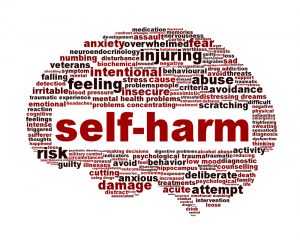Top 5 Things to Know about Self-Harm
This week, we are raising awareness on a subject that can be incredibly distressing and confusiong – self-harm. If you or someone you know has struggled with self-harm, you will know that it comes in different forms and can stem from a multitude of emotional problems. Here, we’ll take a look at some of the myths and facts of self-harm.
- What is self-harm? Self-harm, also known as self-injury, is a self-inflicted, purposeful behavior meant to inflict harm on your body. Though the triggers could range from depression to anxiety to trauma, self-harm is used as a way to relieve emotional pain by causing physical pain. In the moment, it may help an individual feel soothed, but of course, self-injury is dangerous and does not address the true emotional issue needing attention
- How does it look? Self-harm can include any sort of damage to one’s body – this can include cutting, scratching, self-bruising, punching oneself, or other methods. It can also look like other types of physical and mental harm, including eating disorders, drug and alcohol abuse, risky sexual behaviors, and other types of risky behaviors. Sometimes it can look like neglecting hygiene, which could indicate depression or self-esteem problem. While hair-pulling (or trichotillomania) can sometimes be a form of self-harm, it may also be a symptom of anxiety.
- Who is at risk? Teenagers, females, and sexual minorities are at highest risk for self-harm, in addition to individuals who have had adverse childhood experiences/trauma, social problems, and other mental health problems (depression, bipolar disorder, etc.)
- What should I look for? There are several ways to identify someone who is self-harming – you may see unexplained cuts, burns, scars, or wounds and individuals might tell difficult-to-believe stories to justify the injuries. Those who cut on their wrists or arms may wear long sleeves (even in warm weather), sweatbands, or jewelry to cover wounds. They may be reluctant to swim or expose those areas. Those who self-harm may also carry around unusual objects such as razors, contorted paper clips, etc.
- What should I do to help? Individuals with self-harming tendencies should be gently encouraged to seek mental health counseling as soon as possible. They can help an individual develop healthy coping skills for emotional distress and provide family support to help understand self-harm. Also be sure that injuries have not become infected and visit a medical professional as needed.
Keep in mind that just because someone self-harms, it does not mean that they are thinking about suicide, though they have a higher risk than individuals who do not self-harm. Regardless, self-harm is dangerous. Remember, this is a maladaptive method of dealing with distressing emotions, so be gentle and compassionate when confronting someone who may be self-harming. Take time to understand the emotions behind the behavior rather than punishing them or forcing them to stop. Instead, be supportive and remove dangerous objects from their access.
Here are a few more resources to help you understand self-harm:
https://www.mind.org.uk/information-support/types-of-mental-health-problems/self-harm/#.Wrpofh3wbIV
https://www.helpguide.org/articles/anxiety/cutting-and-self-harm.htm
Help is possible, and self-harm can be stopped to preserve the bodies and minds of precious people.
-Mary
